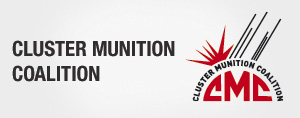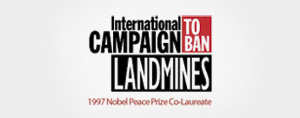03 September 2013
Press Release
Record-breaking Progress as States Race to Eliminate the Scourge of Cluster Bombs: Syria’s use of the banned weapon strongly condemned
(Geneva, 4 September 2013): Governments are making record-breaking progress as they race to fulfill the 2008 treaty banning cluster munitions, while Syria’s use of this banned weapon has been widely condemned, according to Cluster Munition Monitor 2013, a global report released today in Geneva.
“The impressive rate at which states are destroying millions of stockpiled cluster munitions shows that the Convention on Cluster Munitions is already making a real difference in saving lives,” said Mary Wareham of Human Rights Watch, ban policy editor of Cluster Munition Monitor 2013. “By completing their stockpile destruction years in advance of deadline, states are boldly demonstrating their commitment to the treaty’s objective of ridding the world of these weapons.”
During 2012, the Netherlands finished the total destruction of its once-massive stockpile of cluster munitions and together with Denmark, France, Germany, Italy, the United Kingdom, and others, destroyed a total of 173,973 cluster munitions and 27 million submunitions—the most in a year since the convention’s adoption and far exceeding 2011 totals, when states destroyed a total of 107,000 cluster munitions and 17.6 million submunitions.
Under the 2008 Convention on Cluster Munitions, States Parties have a maximum period of eight years to destroy their stockpiled cluster munitions, but most are completing their destruction in half that time. Denmark and the United Kingdom, for example, announced plans to finish destruction by the end of this year, and Cote d’Ivoire finished destruction in early 2013.
The Convention on Cluster Munitions comprehensively prohibits the use, production, transfer, and stockpiling of cluster munitions. It also requires clearance of cluster munition remnants within 10 years and immediate access to assistance for victims of the weapons. A total of 112 countries have joined the convention, of which 83 have ratified or acceded, becoming States Parties fully bound by its provisions.
According to Cluster Munition Monitor 2013:
- Seven signatories have ratified the convention in the past year, including two countries where cluster munitions have been used (Chad and Iraq) and one cluster munition stockpiler (Peru). Most of the remaining 29 signatories are in the process of ratifying.
- Major stockpilers have indicated they will complete destruction years in advance of the deadline, including Denmark and the UK (by the end of 2013), Italy and Sweden (in 2014), and Germany and Japan (in 2015).
- In 2012, more than 59,171 unexploded submunitions were destroyed during clearance of almost 78km2 of land, an area nearly five times the size of Geneva and 40% more land than in 2011.
“The more rapid pace of clearing contaminated land is a very positive trend for those communities still suffering long after cluster munitions are used,” said Kathryn Millett of Norwegian People’s Aid, mine action editor of Cluster Munition Monitor 2013. “As this year’s Monitor details, states and their partners are employing improved evidence-based practices to survey, clear, and release land, especially in heavily contaminated countries.”The report also found:
- Over time, cluster munition casualties had been reported in 31 states as well as in three other areas. In 2012, 190 cluster munition casualties were identified; this is the highest one-year casualty total since the convention entered into force.
- Syria suffered the highest number of victims in 2012 with at least 165 new casualties reported from cluster munition attacks. Additional casualties from cluster munition remnants were confirmed in Cambodia, Lao PDR, Lebanon, Serbia, Sudan, Syria, and Vietnam, as well as Nagorno-Karabakh.
“Syria’s extensive use of cluster munitions has caused needless civilian casualties, but the widespread condemnation of its use of this banned weapon shows the stigma against cluster munitions is strong,” said Wareham.
Cluster Munition Monitor 2013 details extensive use of cluster munitions by the Syrian government in the second half of 2012 and first half of 2013. A total of 113 states have condemned Syria’s use of cluster munitions, including dozens of states outside the convention.
Myanmar government forces may have used a weapon prohibited by the Convention on Cluster Munitions in late 2012 and early 2013, and there were unconfirmed reports of cluster munition use by Sudan in 2012 and 2013. Libya and Thailand used cluster munitions in 2011. None of these states have joined the Convention on Cluster Munitions. There have been no confirmed reports or allegations of new use of cluster munitions by any State Party or signatory to the Convention on Cluster Munitions since it was first signed in December 2008.
Additional findings include:
With Iraq’s ratification in May 2013, nearly three-quarters of cluster munition victims now live in States Parties to the convention. These states are legally obliged to ensure that these victims are provided with adequate assistance, including those killed or injured as well as their families and affected communities.
- Half of all States Parties have enacted legislation to enforce the ban on cluster munitions or declared that existing legislation will suffice to ensure implementation of the convention.
- Nine States Parties have enacted legislation that explicitly prohibits investment in cluster munitions, including Samoa in 2012, and Liechtenstein, the Netherlands, and Switzerland in 2013.
“While states on board the Convention on Cluster Munitions are making impressive progress, too many countries remain outside this landmark humanitarian disarmament treaty,” said Jeff Abramson, final editor of the report and Program Manager for the Landmine and Cluster Munition Monitor. “With only a handful of exceptions, non-signatories are adhering to the ban, but few seem to have made real progress toward officially acceding to the treaty.”
Since the Convention on Cluster Munitions entered into force on 1 August 2010, states that had not already signed must accede to it. Only four countries have acceded: Andorra on 9 April 2013, and Grenada, Swaziland, and Trinidad and Tobago in 2011.
Countries that have previously signed must still ratify in order to become States Parties.
After many years of deliberations, the 1980 Convention on Conventional Weapons (CCW) in 2011 failed to conclude a new protocol aimed at regulating cluster munitions, affirming the status of the Convention on Cluster Munitions as the sole international instrument dedicated to eradicating these weapons. Yet none of the states that sought a new international law on cluster munitions through the CCW have since joined the Convention on Cluster Munitions.
Cluster Munition Monitor 2013 is being launched by the international Cluster Munition Coalition in advance of the convention’s Fourth Meeting of States Parties, which opens in Lusaka, Zambia on Monday, 9 September. It is the fourth annual Cluster Munition Monitor report and the sister publication to the Landmine Monitor report, which has been issued annually since 1999.
About the Monitor:
Created in June 1998 by the International Campaign to Ban Landmines (ICBL), 1997 Nobel Peace Prize co-laureate, the Monitor serves as the research arm of both the ICBL and the Cluster Munition Coalition (CMC). The initiative is coordinated by a Monitoring and Research Committee comprised of ICBL-CMC expert staff and representatives of five non-governmental organizations: Action on Armed Violence, Handicap International, Human Rights Watch, Mines Action Canada, and Norwegian People’s Aid.
Cluster Munition Monitor 2013 reviews policy on joining the Convention on Cluster Munitions as well as adherence to the ban on use, production, trade, and stockpiling in every country in the world. It provides information on cluster munition contamination and casualties, as well as clearance and victim assistance. Baseline data is available in online country profiles, while the overviews in the report provide global analysis and findings. The report focuses on calendar year 2012, with information included up to July 2013 when possible.
Press release also available in French, Spanish, Arabic
Read the report here.



